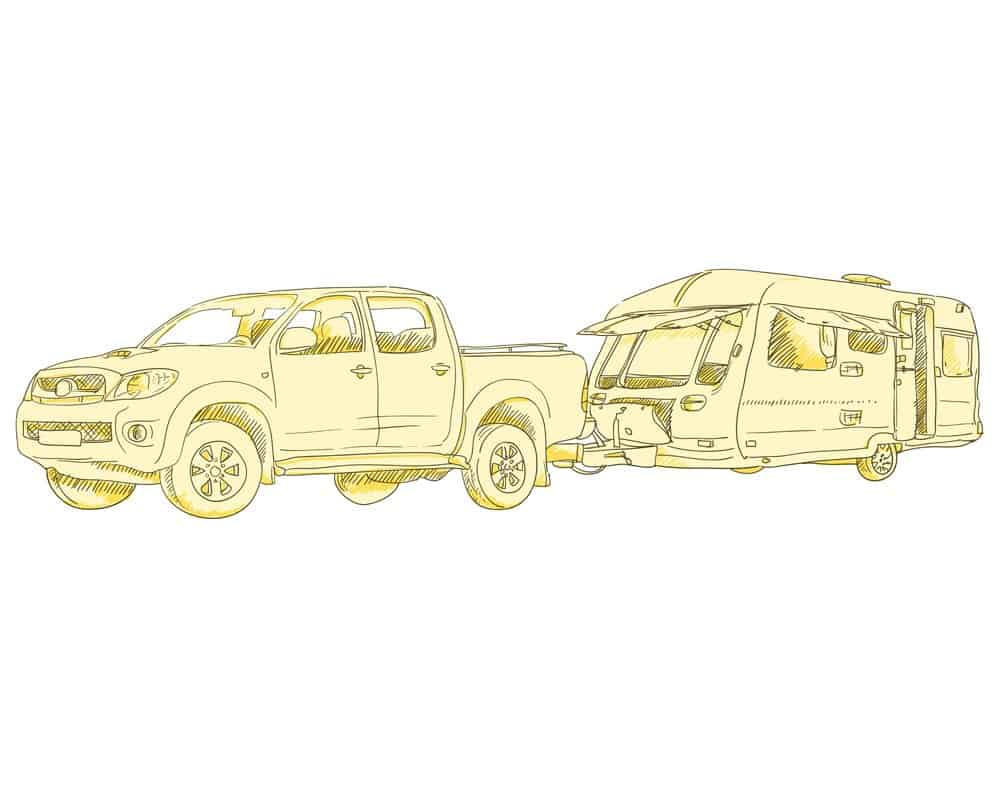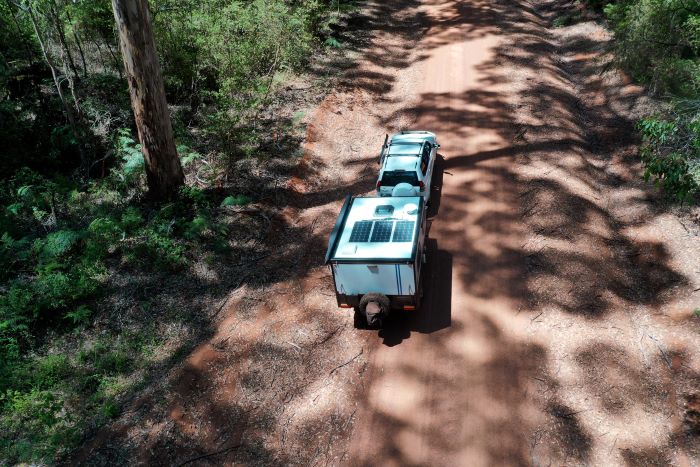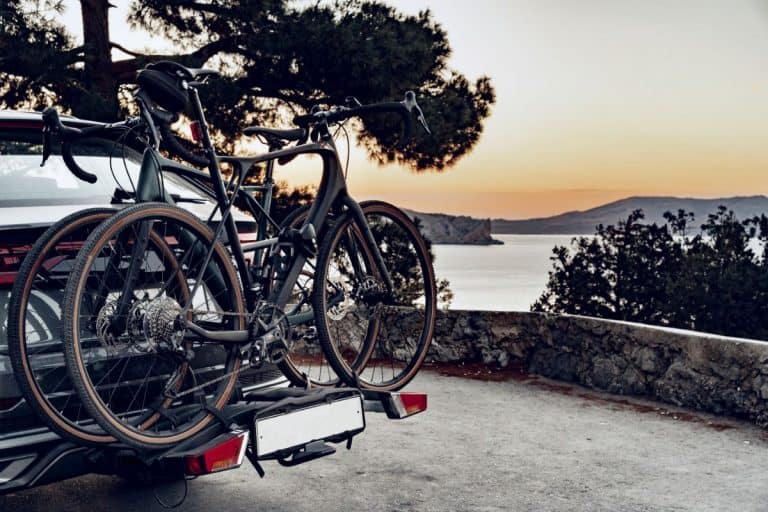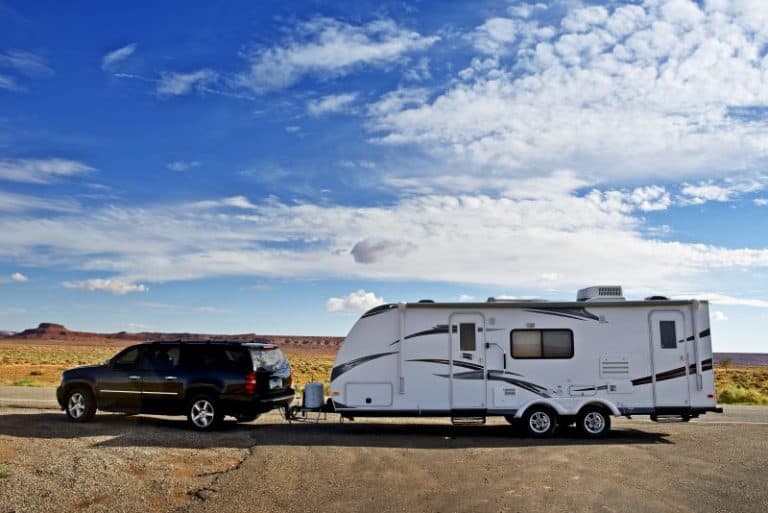What is a GVM, GCM and ATM?
The weight of your vehicle and caravan is extremely important when you are towing. You must know the weights you are allowed to have both legally and for safety reasons. Cars, camper trailers and caravans are all designed to carry or tow a specific amount of weight, and not going over this is crucial to their safe and efficient operation.
The most common car and caravan weights are:
GVM (gross vehicle mass) = vehicle tare mass + maximum payload
GCM (gross combination mass) = GVM + GTM
ATM (aggregate trailer mass) = tare mass (caravan) + max payload
GTM (gross trailer mass) = ATM – tow ball mass
Working out all the weights involved in towing can be confusing, especially when people start talking things like GVM, ATM and tare weights. But if you’re going to be choosing a car to safely (and legally) tow a camper trailer or caravan it is important you get your weight right.
Vehicle and Caravan Weights Explained
Tare weight/mass
This is the weight of your empty vehicle. In cars, it is the empty vehicle with all fluids (oils, coolants etc) but only 10 litres of fuel.
For your caravan, the tare weight means the weight of your empty trailer with any fluids needed (such as for brakes) but NOT the water in the fresh or grey water tanks, or the gas in any gas bottles. Tare mass is usually weighed at the manufacturer, so it is a good idea to ask your dealer if the tare weight includes any accessories that have been added on (such as air conditioners or awnings). If you or your dealer adds on any accessories after manufacture, this will come out of your payload amount (see separate heading).
Think of it as the starting weight of your trailer. The best way to know the true tare weight of your caravan or camper is to weigh it yourself at a public weighbridge. Make sure you do this before you add any of your belongings to the caravan.
Vehicle Kerb weight
This is similar to the tare weight but with a full tank of fuel included. It does not include any accessories that you fit to your vehicle such as bull bars, tow bars, roof racks etc.
Gross Vehicle Mass (GVM)
GVM = vehicle tare mass + maximum payload
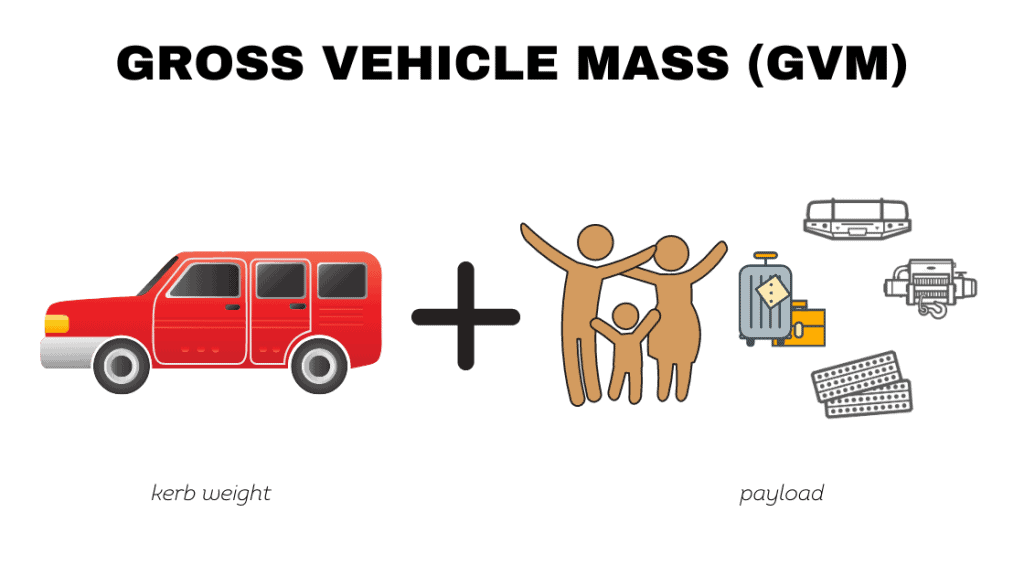
This amount is the maximum your vehicle can weight when fully loaded. It includes the kerb mass, all accessories (bull bars, roof racks, tow bars, winches etc) and the payload (see separate heading below). If you are towing something with your vehicle it also needs to include the tow ball mass.
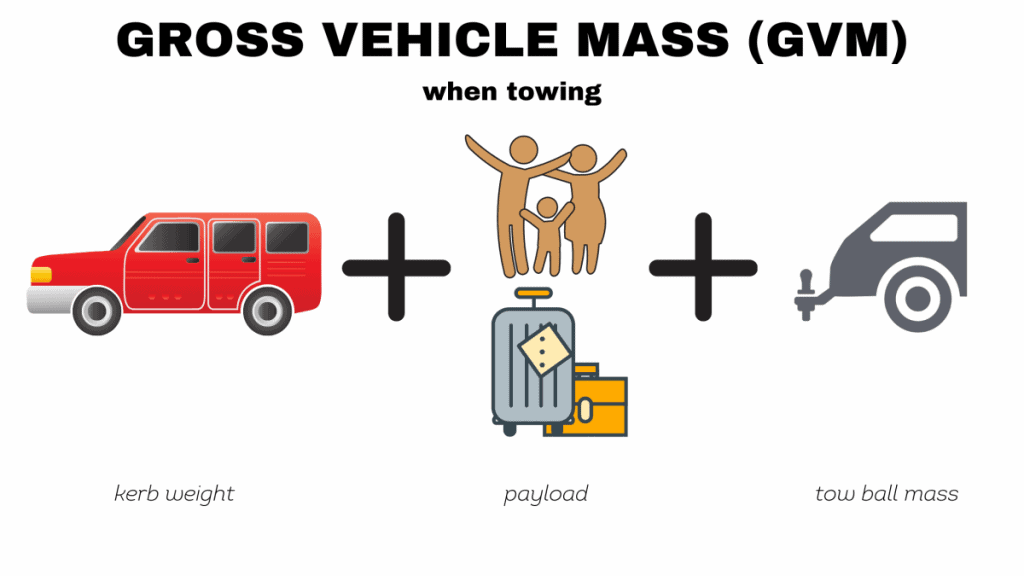
This amount is specified by the manufacturer and you can find this figure on the weight placard (usually found in the driver’s door opening) or in the owner’s manual.
Aggregate Trailer Mass (ATM)
ATM = tare mass (caravan/trailer) + max payload
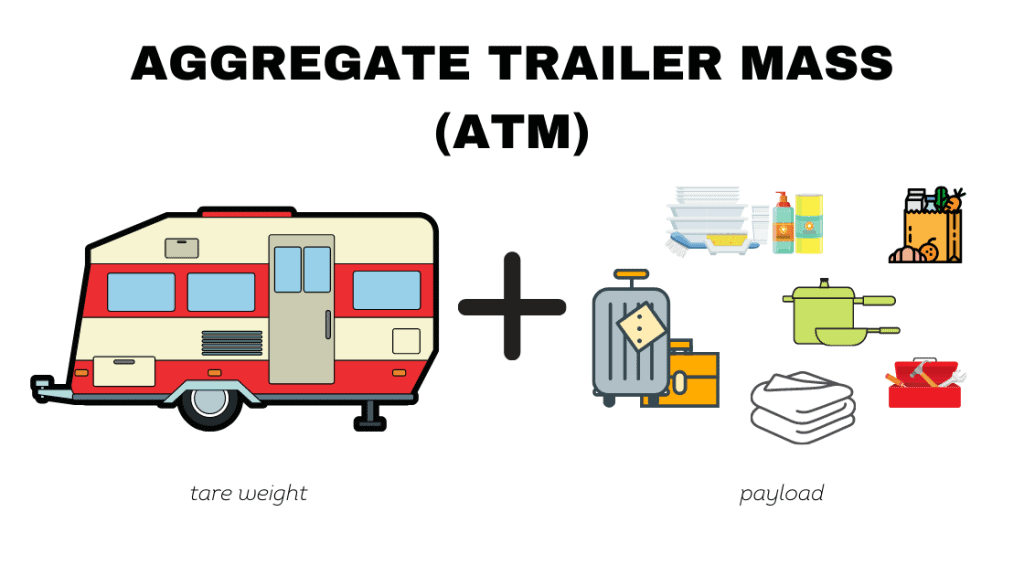
The ATM is the maximum towing weight of the caravan or camper. This amount is specified by the manufacturer and you cannot go over it. It includes the weight of the trailer, tow ball mass (see separate heading below) and the payload (see separate heading below) the trailer can carry.
It is the total weight of your caravan or camper trailer when it is in the driveway packed and ready to go for your trip.
Gross Trailer Mass (GTM)
This is the maximum weight the axle in your trailer can carry. It is specified by your manufacturer. This amount is the combined weight of your trailer plus its payload (see separate heading below) but does not include the tow ball mass (see separate heading below).
GTM = ATM – Tow ball mass
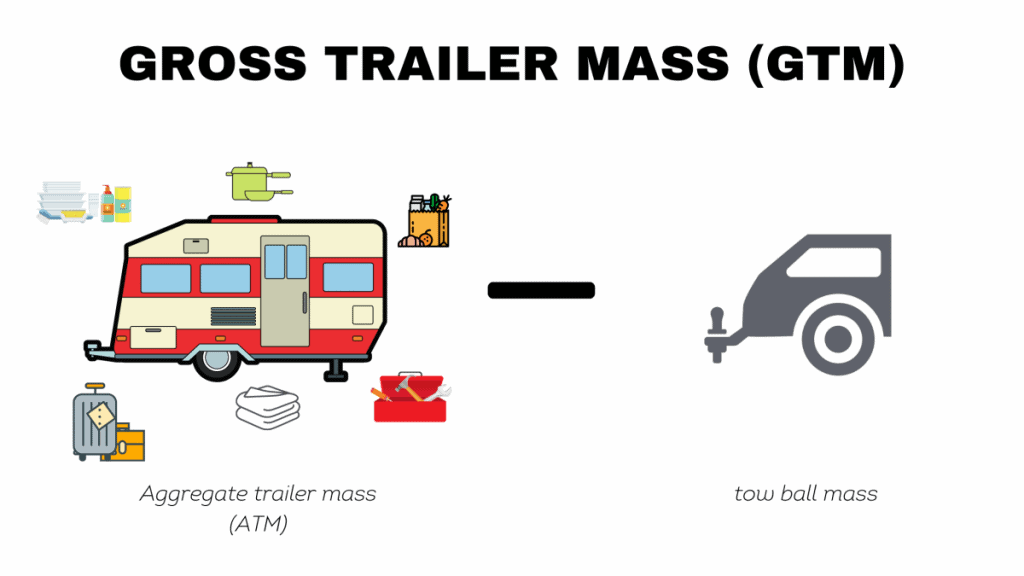
The GTM is usually displayed on the trailer and can also be found in the owner’s manual.
Payload
Vehicle payload = GVM – kerb weight OR Vehicle payload = GVM – (tare weight + fuel)
Caravan payload = ATM – tare mass
The payload is the amount of weight your vehicle or caravan can carry.
In a vehicle it is simply the GVM minus the kerb weight). You can also work it out by GVM – (tare weight + Fuel). You are then left with the payload amount. The payload includes all accessories added including bull bars, roof racks, canopies etc, people riding in the car and all luggage. If you are towing, the payload also includes the tow ball mass.
Payload is where most people exceed the GVM of their vehicle as they forget that they need to account for the weight of all added accessories as well as any people that will be in the vehicle. The payload needs to account for ALL weight added to the car above the tare weight – not just the luggage in the boot.
In a caravan or camper, it is the aggregate trailer mass minus the tare mass. If you have weighed your empty caravan (with all accessories fitted) then you will have a true tare mass to work with and the payload is the amount you can load into your camper. This payload amount needs to include the water in your water tanks and the gas in your gas bottles, but does not need to include people that would be in your camper when stationary (as they will be in the car when towing).
Tow Ball Mass
This can also be known as the tow bar download. It is the downward pressure put onto the tow ball from the weight of the camper or trailer. The amount of weight put onto your tow bar is crucial to the safe and efficient operation of your vehicle. Too much weight on your tow bar can cause issues with towing.
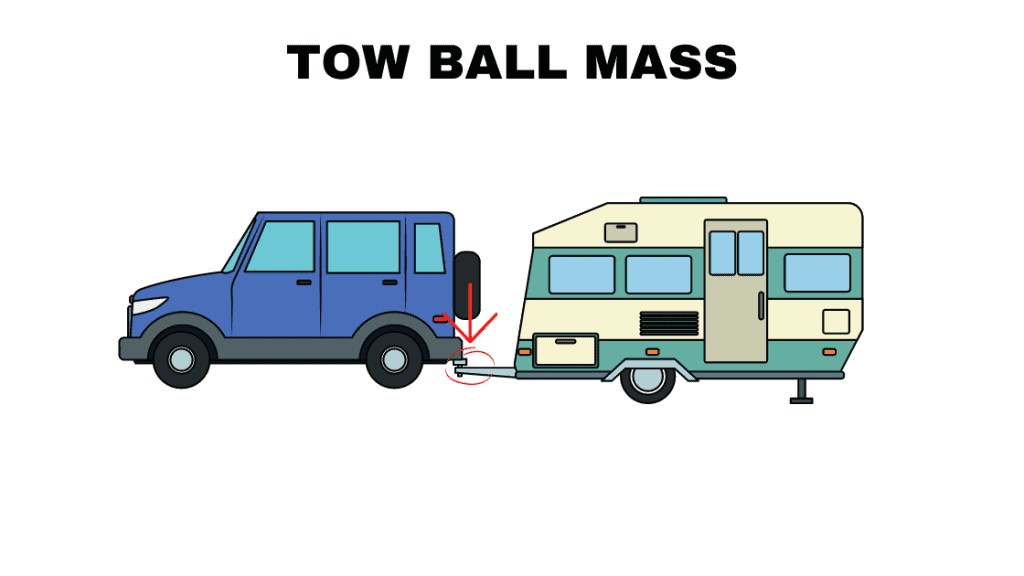
The tow bar itself should have a placard on it showing the maximum tow bar capacity and maximum tow bar download. Make sure you have chosen the correct one for both your vehicle and the amount of weight you want to tow.
The tow ball weight of your caravan or camper should be on its VIN plate. It’s important to remember that if you change anything (especially adding something onto the draw bar of your camper) this could have an impact on the tow ball weight.
Gross Combination Mass (GCM)
GCM (gross combination mass) = GVM (gross vehicle mass) + GTM (gross trailer mass)
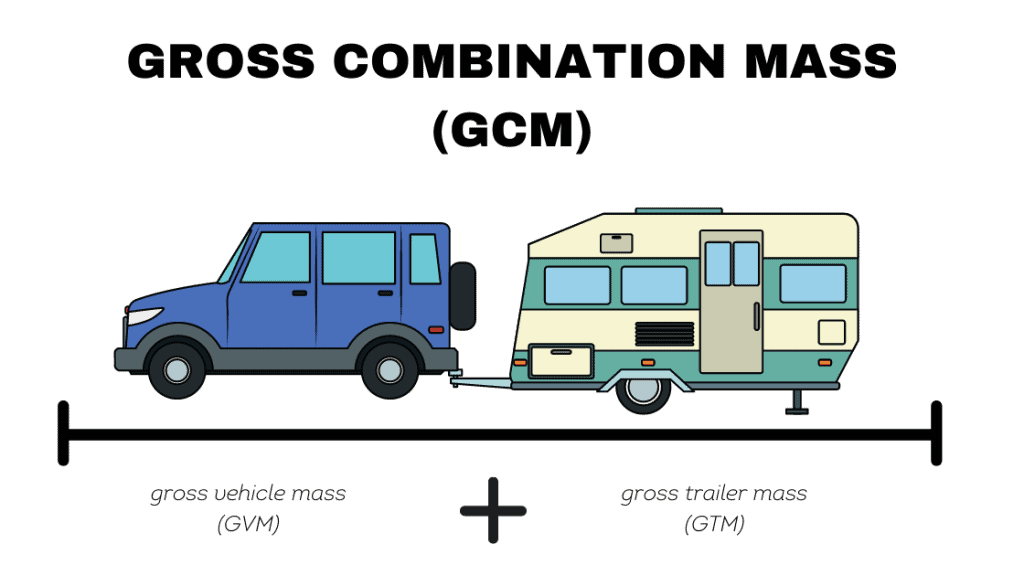
The gross combination mass or GCM is the total weight of your car and trailer together. There is a maximum GCM that your vehicle can have, and this amount can be found in your cars owner’s manual.
When you are towing a caravan or camper trailer gross combination mass is one of the most important numbers to get right. Exceeding this calculation can not only make what you are driving unsafe, but it is also illegal and if you do have an issue or an accident, you may not be covered by your insurance.
The GCM can be found by adding your gross vehicle mass and your gross trailer mass together. It is important to note that if you are loading your car to it’s maximum GVM then in most situations you will not be able to use the full advertised towing capacity for vehicles as you would go over the CGM.
The GCM is a bit of a balancing act. You need to consider how much weight is in your vehicle, in your trailer and on your tow ball. If you add more to one you need to take some off somewhere else to ensure your total weight is below the GCM.
Gross Combination Mass (GCM) Example
Let’s take a look at a real-life example. This is our car and camper trailer.
Our Car
| Kerb Weight (KW) | 2,025 kg |
| Maximum Gross Vehicle Mass (GVM) | 2,710 kg |
| Gross Combination Mass (GCM) | 5,210 kg |
| Maximum Towing Mass (braked) | 2,500 kg |
| Tow Ball Mass | 250 kg |
| Payload (GVM – KW) | 685 kg |
Our car has a gross vehicle mass of 2710 kg and a kerb weight of 2,025. This gives us 685 kg of payload which includes any accessories we want to add, kids car seats, the people in the vehicle and any luggage before we hit out limit. Given our family weighs about 195 kg all together that actually leaves us with 490kg for everything else. You also need to keep in mind that once you start towing, the tow ball mass of the trailer comes into the payload as well.
Our Camper Trailer
| Tare Weight | 1,000 kg |
| Aggregate Trailer Mass (ATM) | 1,300 kg |
| Gross Trailer Mass (GTM) | 1,230 kg (ATM – TBM) |
| Tow Ball Mass (TBM) | 70 kg |
| Payload (GTM – Tare) | 230 kg |
As you can see, we travel with a fairly light camper trailer and a light tow ball mass.
Working out Gross Combination Mass
If we hook on our camper trailer we have approximately 420 kg of payload left for our car. We also have approx. 230 kg of payload in our trailer. We have two kids and want to go travelling for a few weeks, so that would be taken up pretty quickly with luggage, food, water, gas and accessories.
If we load our car and camper to the maximum GVM and ATM then our gross combination mass would be:
GVM = 2,710 kg
GTM = 1,230 kg
GCM = GVM + GTM = 2710 + 1230 = 3940
This gives us a gross combination mass of 3,940 kg which is well under our maximum allowable GCM of 5,210 kg. So as long as we’re careful not to go over the payload on our trailer or car, will we able to tow safely and legally.
But what if we want to upgrade to a caravan?
Let’s take a look at the below example of a caravan. We have two kids so need something with bunkbeds. This one is a 19 ft so a definite upgrade in size from a camper trailer, but not as big as some of the family vans available.
Caravan
| Tare Weight | 2,292 kg |
| Aggregate Trailer Mass (ATM) | 2,952 kg |
| Gross Trailer Mass (GTM) | 2,767 kg (ATM – TBM) |
| Tow Ball Mass (TBM) | 185 kg |
| Payload (GTM – Tare) | 475 kg |
Straight away we need to account for the higher tow ball weight on the car, so the 490 kg payload in our vehicle now becomes 305 kg. Something to think about when deciding what to pack in our car (or adding on accessories) so that we don’t go over our GVM.
Next we need to look at our GCM.
GVM = 2,710 kg
GTM = 2,767 kg
GCM = GVM + GTM = 2710 + 2767 = 5477
As you can see, if we were to tow this van and had it fully packed, we would be over our allowable gross combination mass by 267 kgs. We would also be over the maximum towing mass available to the car. Not only would we be driving illegally, it would also likely be unsafe and we’d be using our car at its absolute maximum so it’s unlikely to perform very well towing that mass anyway. This is a big amount to go over and it’s unlikely that we’d be able to unpack nearly 300 kgs of stuff so our only options would be to get a lighter caravan or a different vehicle.
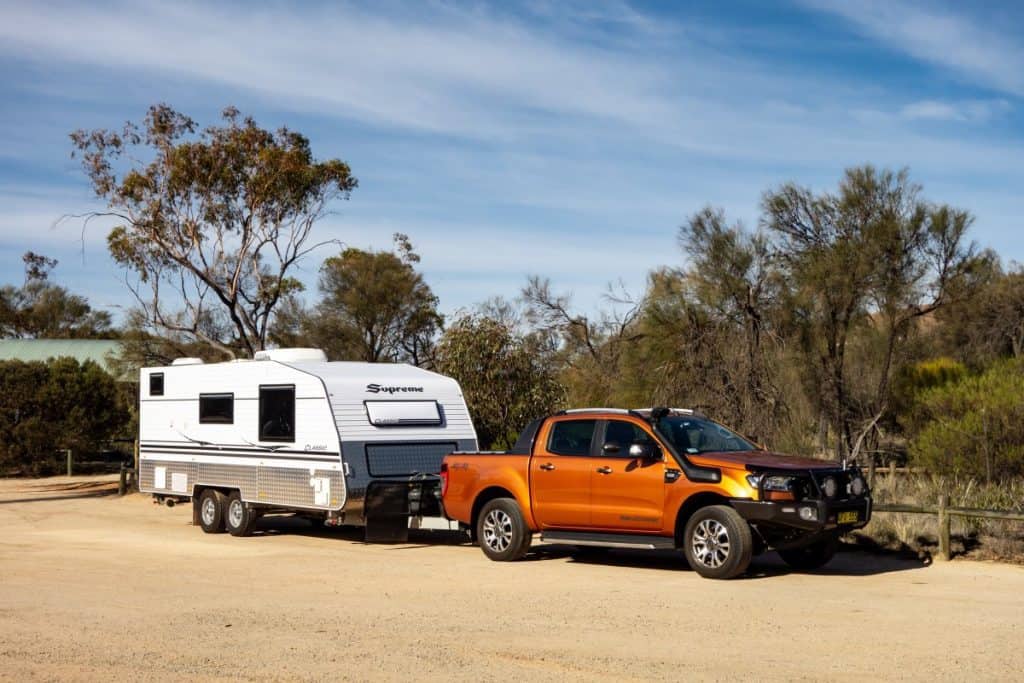
Common mistakes made when calculating your vehicle and caravan weights
GVM, GTM and GCM are so important to the safety of your towing journey so it’s important to get the calculations right. There are quite a few common mistakes people make when calculating their weights.
- Have you considered your cars accessories? Unless your accessory came standard at the manufacturer, they are unlikely to be considered in your kerb weight and so must come out of your payload. Things like nudge bars, snorkels, drawer systems, extra batteries, fridges etc are all things that need to be taken into account. A lot of people tend to forget about these things once they are attached to the car.
- Have you weighed your vehicle and caravan to get the correct amounts? Did you know you can weigh your vehicle and caravan at a public weighbridge to get accurate weights? There are even companies that bring mobile stations to you. It is a good idea to weight both your car and trailer empty, and then full of what you usually take travelling so that you have the correct figures to work with. You may find that the tare weight written on your VIN plate is incorrect, or that you’ve packed more weight than you thought.
- Don’t forget about liquids. Many people forget to account for their full tank of fuel, or things like the water tank in their camper. Tare weights for a camper or caravan don’t include things like water and gas, so if you have a 70L water tank which you fill up when going away, that is 70 kgs out of your payload already.
- Don’t estimate. It is all well and good to estimate the weights of things if you are no where near your GVM or ATM, but if you’re getting a bit close a few kilos here or there can make a big difference. Try to get accurate weights of the things you are adding in so you have a complete picture. If you do have to estimate, try to estimate up not down.
- Double check your GCM. Some vehicles gross combination mass is equivalent to the GVM plus the vehicles maximum towing capacity. For example, our car has a GCM that is equal to our GVM and maximum towing of 2,500 kg. However, some vehicles have a GCM lower than this and if you actually load up the car to its maximum GVM it reduces the amount you can tow. It is important to not just assume that you can make your car it’s heaviest and then still tow its maximum weight. Double check the GCM to make sure you don’t have to reduce weight in some area. If you want to tow a caravan at it’s maximum, you may find you need to reduce the weight of the car to stay under the GCM.
- Look at your tow ball download. A manufacturer may claim a certain tow ball mass figure, however if you change anything, then that figure will change. Any extras you add onto the drawbar, or if you pack to much weight towards the front of the trailer instead of over the axles will mean that your tow ball mass increases.
- Check your tyres. If you are changing your tyres, make sure that the new one’s can support the amount of weight you are planning on having on them. Not all tyres are created equal.
All these acronyms and figures may seem daunting at first, but it is important if you are towing, that you can understand what they are. You’ll find the tare, ATM, TBM and GTM stamped on the vehicle identification number (VIN) plate or your vehicle, caravan or camper trailer as well as GVM and GCM in your owner’s manual. With exception of the tare, as long as you don’t exceed any of these figures, then you shouldn’t have any problems towing your caravan both legally and safely.

